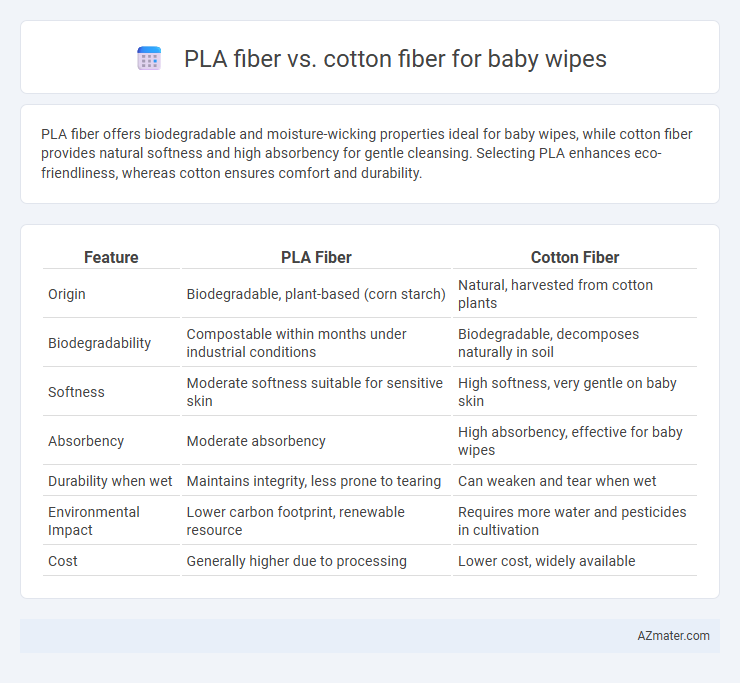PLA fiber offers biodegradable and moisture-wicking properties ideal for baby wipes, while cotton fiber provides natural softness and high absorbency for gentle cleansing. Selecting PLA enhances eco-friendliness, whereas cotton ensures comfort and durability.
Table of Comparison
| Feature | PLA Fiber | Cotton Fiber |
|---|---|---|
| Origin | Biodegradable, plant-based (corn starch) | Natural, harvested from cotton plants |
| Biodegradability | Compostable within months under industrial conditions | Biodegradable, decomposes naturally in soil |
| Softness | Moderate softness suitable for sensitive skin | High softness, very gentle on baby skin |
| Absorbency | Moderate absorbency | High absorbency, effective for baby wipes |
| Durability when wet | Maintains integrity, less prone to tearing | Can weaken and tear when wet |
| Environmental Impact | Lower carbon footprint, renewable resource | Requires more water and pesticides in cultivation |
| Cost | Generally higher due to processing | Lower cost, widely available |
Introduction to PLA Fiber and Cotton Fiber
PLA fiber, derived from renewable resources like cornstarch, offers biodegradability and eco-friendliness, making it a sustainable alternative for baby wipes. Cotton fiber, a natural and highly absorbent material, provides softness and breathability, which are important for sensitive baby skin. Comparing the two, PLA fibers excel in environmental impact while cotton fibers prioritize comfort and traditional quality.
Key Differences Between PLA and Cotton Fibers
PLA fiber, derived from renewable plant starches like corn, offers biodegradability and moisture resistance, making it ideal for eco-friendly baby wipes. Cotton fiber, a natural plant-based material, provides superior softness and absorbency but may retain moisture longer, increasing irritation risk on delicate baby skin. While PLA fibers excel in sustainable production and quick biodegradation, cotton fibers remain preferred for their comfort and breathability in sensitive baby care products.
Sustainability and Environmental Impact
PLA fiber, derived from renewable resources like corn starch, offers excellent biodegradability and compostability, significantly reducing landfill waste compared to conventional cotton fibers. Cotton cultivation requires substantial water, pesticides, and land use, which contributes to environmental degradation and higher carbon emissions. Using PLA fiber in baby wipes enhances sustainability by lowering water consumption, minimizing chemical inputs, and accelerating decomposition, making it a more eco-friendly choice than traditional cotton.
Biodegradability and Compostability
PLA fiber, derived from renewable resources like corn starch, offers excellent biodegradability and compostability under industrial composting conditions, breaking down within 90 to 180 days. Cotton fiber, a natural cellulose fiber, is inherently biodegradable and compostable in home and industrial environments but may take longer, often several months to a year, to decompose fully. For baby wipes, PLA fiber provides a sustainable alternative with faster industrial composting rates, while cotton emphasizes natural origin and compatibility with traditional composting methods.
Baby Skin Safety and Hypoallergenic Properties
PLA fiber offers superior baby skin safety due to its biodegradable, non-toxic nature, reducing irritation and allergic reactions compared to conventional fibers. Cotton fiber, renowned for its natural softness and breathability, provides excellent hypoallergenic properties ideal for sensitive baby skin. Both fibers support gentle cleansing, but PLA's eco-friendly profile enhances safe, irritation-free baby wipe usage.
Absorbency and Cleaning Efficiency
PLA fiber exhibits superior absorbency compared to cotton fiber, effectively retaining moisture and enhancing the cleaning efficiency of baby wipes. Its hydrophilic properties enable rapid liquid uptake, reducing residue on sensitive baby skin while maintaining softness. In contrast, cotton fibers, although naturally absorbent, tend to hold more moisture on the surface, potentially requiring more wipes for thorough cleaning.
Durability and Strength in Baby Wipes
PLA fiber offers enhanced durability and tensile strength compared to cotton fiber, making baby wipes more resistant to tearing during use. Cotton fibers tend to absorb moisture quickly but may weaken and break under stress, whereas PLA fibers maintain structural integrity when wet. As a biodegradable polymer, PLA ensures both strength and eco-friendliness, ideal for durable yet gentle baby wipes.
Cost Comparison: PLA vs. Cotton Baby Wipes
PLA fiber baby wipes generally present a higher upfront cost compared to cotton wipes due to the expenses involved in manufacturing and sourcing biodegradable PLA materials. Cotton wipes typically offer a lower price point influenced by the widespread availability and established production processes of cotton fiber. The long-term cost-effectiveness of PLA wipes may improve with increased demand and advancements in sustainable production, potentially narrowing the price gap with cotton alternatives.
Consumer Perceptions and Preferences
Consumers increasingly prefer PLA fiber for baby wipes due to its biodegradability and eco-friendly attributes, aligning with growing environmental awareness. Cotton fiber retains strong appeal for its natural softness, hypoallergenic properties, and absorbency, which parents associate with gentle care for sensitive baby skin. Market research reveals a rising segment favoring PLA fiber wipes for sustainability, while cotton-based wipes continue to dominate in tactile comfort and trustworthiness.
Which Fiber Is Better for Baby Wipes?
PLA fiber offers superior biodegradability and hypoallergenic properties compared to cotton fiber, making it an eco-friendly choice for baby wipes. Cotton fibers, while soft and highly absorbent, often require extensive water and pesticide use in cultivation, raising sustainability concerns. For baby wipes, PLA fiber provides a combination of gentle texture and environmental benefits, positioning it as a better option for sensitive baby skin and green consumer preferences.

Infographic: PLA fiber vs Cotton fiber for Baby wipe
 azmater.com
azmater.com